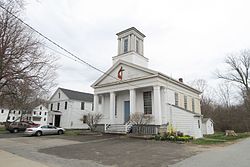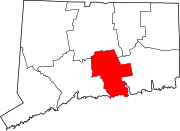This is an old revision of this page, as edited by 2604:2000:2fc0:f:19f5:cb73:a6a8:89b7 (talk) at 07:36, 5 June 2020. The present address (URL) is a permanent link to this revision, which may differ significantly from the current revision.
Revision as of 07:36, 5 June 2020 by 2604:2000:2fc0:f:19f5:cb73:a6a8:89b7 (talk)(diff) ← Previous revision | Latest revision (diff) | Newer revision → (diff)Village and census-designated place in Connecticut, United States of America
| Moodus, Connecticut | |
|---|---|
| Village and census-designated place | |
 Moodus United Methodist Church Moodus United Methodist Church | |
  | |
| Coordinates: 41°30′10″N 72°27′00″W / 41.50278°N 72.45000°W / 41.50278; -72.45000 | |
| Country | United States of America |
| State | Connecticut |
| County | Middlesex |
| Town | East Haddam |
| Area | |
| • Total | 2.9 sq mi (8 km) |
| • Land | 2.9 sq mi (8 km) |
| • Water | 0.04 sq mi (0.1 km) 0.69% |
| Elevation | 230 ft (70 m) |
| Population | |
| • Total | 1,413 |
| • Density | 490/sq mi (190/km) |
| Source: U.S. Census Bureau, 2010 Census | |
| Time zone | UTC-5 (EST) |
| • Summer (DST) | UTC-4 (EDT) |
| ZIP code | 06469 |
| Area code | 860 |
Moodus is a village in the town of East Haddam, Connecticut, United States. The village is the basis of a census-designated place (CDP) of the same name. The population of the CDP was 1,413 according to the census of 2010.
History
Prior to its purchase by English settlers in 1662, the area around Moodus was inhabited by Native American Algonquians, three of which tribes are known: the Wangunks, the Mohegans and the Nehantics. The name was derived from the Native American name for the area-- "Matchetmadosett" or Matchitmoodus, the place of noises, possibly because of earthquakes. Numerous earthquakes were recorded in the area between 1638 and 1899. Loud rumblings, the “Moodus Noises,” could be heard for miles surrounding the epicenter of the quakes near Mt. Tom. The land, which is now the towns of Haddam and East Haddam, was purchased by settlers from the Indians during 1662 for thirty coats – worth about $100. The Native Americans worshipped the god of the dead in the land known as Matchetmadosett. The native people would hold celebrations with feasts and orgies to commemorate unity of the tribes.
During the nineteenth century, Moodus was advertised as the “Twine Capital of America,” with twelve mills in operation. The most successful was Brownell & Company. Moodus was in an ideal location for textile production since it had access to ample water power and shipping (via the Connecticut River and the Connecticut Valley Railroad), and it was close to an enormous trading center and market, New York City. Moodus's mills primarily manufactured cotton yarn, cotton duck, and twine, and that production lasted from 1819 to 1977. The mills also produced certain related products, particularly fishing nets and pearl buttons. A part of that textile mill history is preserved in the Johnsonville historical section of Moodus, named after one of the mill owners. Brownell was a pioneer with DuPont Corporation in the production of nylon products, and Brownell still manufacturers specialized textile-related products in Moodus such as archery bowstrings, helicopter cargo nets, and tennis nets.
Moodus had many local resorts that operated during the course of the early and mid-20th century. During the summer seasons of the 1940s and 1950s, people visiting the more than 30 Moodus-area resorts quadrupled East Haddam's population to about 20,000 people. The resorts, boarding houses and camps of Moodus attracted Christian and Jewish vacationers primarily from New York, New Jersey, Massachusetts and other parts of Connecticut. One of the last resorts to remain in operation, Sunrise Resort, was purchased by the state of Connecticut during late 2008 to be incorporated into the adjacent Machimoodus State Park as a campground, and to protect "4,700 feet of additional frontage along the Salmon River".
The village center, dubbed "Downtown Moodus", located formerly at the intersection of routes CT 151 and CT 149, was a popular destination for resort guests. However most of the village was razed after the citizens of East Haddam controversially voted in 1967 to accept urban renewal funding to build a new commercial district for Moodus a quarter mile east, along CT 149. East Haddam was one of the smallest towns in the United States to participate with the urban renewal program.
Geography
According to the United States Census Bureau, the CDP has a total area of 2.9 square miles (7.5 km), of which, 2.9 square miles (7.5 km) of it is land and 0.04 square miles (0.10 km) of it (0.69%) is water.
The area is subject to earthquakes, with an intensity VI quake occurring in 1568, and numerous quakes being recorded from 1638 onwards. The largest earthquake recorded for Connecticut was an intensity VII quake on May 16, 1791 near Moodus.
Demographics
As of the census of 2000, there were 1,263 people, 529 households, and 322 families residing in the CDP. The population density was 438.8 people per square mile (169.3/km). There were 592 housing units at an average density of 205.7 per square mile (79.4/km). The racial composition of the CDP was 97.78% White, 0.40% African American, 0.48% Native American, 0.16% Asian, 0.79% from other races, and 0.40% from two or more races. Hispanic or Latino of any race were 1.27% of the population.
There were 529 households out of which 31.8% had children younger than age 18 living with them, 43.7% were married couples living together, 11.3% had a female householder without a husband present, and 39.1% were non-families. 31.9% of all households were composed of individuals and 14.7% had someone living alone who was 65 years of age or older. The average household size was 2.39 and the average family size was 3.05.
In the CDP, the age distribution was 25.7% younger than age 18, 5.7% from 18 to 24, 33.8% from 25 to 44, 21.9% from 45 to 64, and 12.9% who were 65 years of age or older. The median age was 37 years. For every 100 females, there were 102.1 males. For every 100 females age 18 and older, there were 95.0 males.
The median income for a household in the CDP was $52,188, and the median income for a family was $68,500. Males had a median income of $42,938 versus $33,214 for females. The per capita income for the CDP was $32,475. None of the families and 2.4% of the population were living below the poverty line, including none younger than age 18 and none of those older than age 64.
Attractions
- Amasa Day House - a historic house museum on Town Street.
- Johnsonville Village - once a thriving mill community, then a Victorian Era tourist attraction, now an abandoned ghost town.
- Machimoodus State Park "Sunrise State Park"
- Cave Hill Resort
Noises
Moodus is infamous in Connecticut for strange noises coming from the woods which have been termed "Moodus noises", and are attributed to shallow micro-earthquakes. The noises can be heard most strongly from Cave Hill, located next to Mt. Tom and owned by the Cave Hill Resort.
In the book Legendary Connecticut, author David Philips asserts that the Moodus noises were the source of an indigenous religious cult important to local Native Americans. Local Algonquin chiefs would gather around Mt. Tom in order to experience the living presence of the god Hobomok. Pequot, Mohegan and Narragansett tribes participated with this cult, and according to local Alison Guinness, the Wongums were involved as well. Hobomok was considered the spirit of the dead and worshipped by the tribe that inhabited the area. The puritains that came to inhabit the area considered him evil. However to the native people he was more like a Zeus, or a Hades, a god that can do good or bad, depending on what mood he was in.
The Moodus noises were the basis for the otherworldly noises in H. P. Lovecraft's The Dunwich Horror. The local high school's athletic teams are dubbed the "Noises".
References
- "Moodus CDP: DP-1 - Profile of General Population and Housing Characteristics: 2010". 2010 United States Census. United States Census Bureau. 2010. Archived from the original on February 12, 2020. Retrieved July 29, 2012.
- "About our Town: History" East Haddam, Connecticut
- Skinner, Charles Montgomery (1969) "Moodus Noises" Myths & Legends of Our Own Land Singing Tree Press, Detroit, Michigan, page 266 OCLC 19933; reprinted from the fifth edition of 1896 of J.B. Lippincott Company.
- "Archived copy". Archived from the original on September 19, 2012. Retrieved January 12, 2012.
{{cite web}}: CS1 maint: archived copy as title (link) - http://www.brownellarchery.com/BrownellCoverStory.pdf
- "History of Mills In Connecticut". Connecticut Water Trails Association. Retrieved February 26, 2012.
- "The Resorts That Put the Mood in Moodus: When Moodus Became a Hot Spot for Vacationers" SimonPure Productions, LLC
- Church, Diane (January 3, 2009) "Sunrise Resort bought by state, open to public" The Herald Press, archive here by Freezepage
- "Legacy of "Progress" Gone Sour" SimonPure Productions, LLC
- "Moodus – East Haddam, Connecticut earthquake" United States Geological Survey
- Staff (1900) East Haddam: a brief history of its past and present (published as a supplement to the Connecticut Valley Advertiser vol. 30, no. 52) Connecticut Valley Advertiser, Moodus, Connecticut, OCLC 8838286
- Perry, Elwyn (1942) "The Moodus Earthquakes and the Cause of Earthquakes in New England" Earthquake Notes 13(1/2): pp. 401–404
- Historic Earthquakes: Near Moodus, Middlesex County, Connecticut, 1791 05 16" United States Geological Survey
- Grant, Ellsworth (2006) "The Moodus Earthquake 1791" Connecticut Disasters: True Stories of Tragedy and Survival Insiders' Guide, Guilford, Connecticut,pages 9–14, ISBN 978-0-7627-3972-1
- "U.S. Census website". United States Census Bureau. Retrieved January 31, 2008.
- Gates, Alexander E. And Ritchie, David (2007) "acoustics" Encyclopedia of Earthquakes and Volcanoes Facts on File, New York, page 1, ISBN 978-0-8160-6302-4
- "Seismic Detective Solves 'Moodus Noises' Mystery" Hartford Courant October 19, 1981
- Ebel, John E. (1989) "A Comparison of the 1981, 1982, 1986, and 1987–1988 Microearthquake Swarms at Moodus, Connecticut" Seismological Research Letters 60: pp. 177–184
- U.S. Geological Survey Geographic Names Information System: Cave Hill
- There are three Mt. Toms in Connecticut and two in Middlesex County. This is the one at 41°29′45″N 72°28′40″W / 41.49583°N 72.47778°W / 41.49583; -72.47778, U.S. Geological Survey Geographic Names Information System: Mount Tom
- ^ Boudillion, Daniel V. (2009) "The Moodus Noises & Moodus Noise Cave"
- Philips, David E. (1992) Legendary Connecticut: Traditional Tales from the Nutmeg State (2nd edition) Curbstone Books, Willimantic, Connecticut, page ?, ISBN 1-880684-05-5
- Lovecraft, Howard Phillips (2001). S. T. Joshi (ed.). The Thing on the Doorstep and Other Stories. Penguin Books. p. 411 – footnote 16. ISBN 0 14 218003 3.
- http://www.edline.net/pages/Nathan_Hale-Ray_High_School/Activities/Athletics
| Municipalities and communities of Middlesex County, Connecticut, United States | ||
|---|---|---|
| County seat: Middletown | ||
| City |  | |
| Towns | ||
| Borough | ||
| CDPs | ||
| Other communities | ||